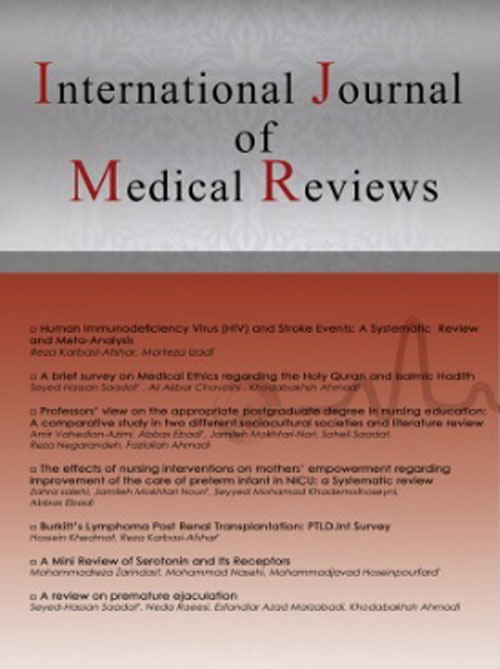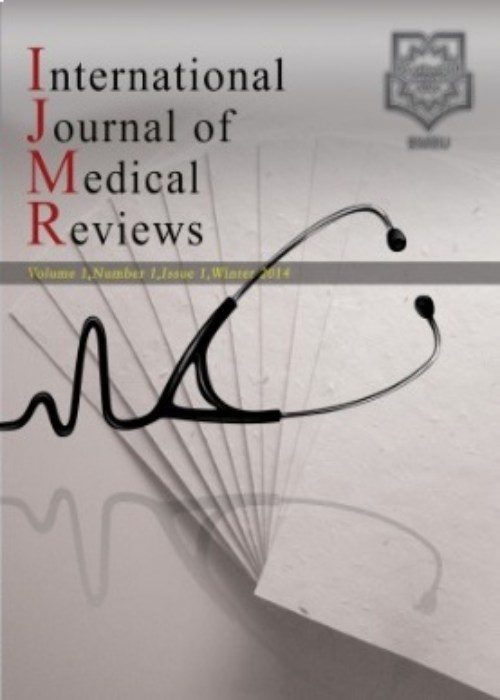فهرست مطالب

International Journal of Medical Reviews
Volume:3 Issue: 2, Spring 2016
- تاریخ انتشار: 1395/03/26
- تعداد عناوین: 8
-
Pages 407-421IntroductionStress has become an inevitable component of postmodern era extending its shade from inner world of mind to intercontinental and global issues. Every deliberate planning especially policy making for public health needs to evaluate the level of stress at first (implicitly affected by diathesis-stress model). The present study is devoted to systematically review of the psychosocial stress-related literature.Materials And MethodsWith the keywords of this systematic review 9 scientific search engines sere searched for Persian and English relevant literature. According to relation to study parts, academic publishing, date of publication and Jadad system, relevant sources were selected. The manuscript then, finalized by evaluation of six experts in psychosocial stress domain via Delphi method.ResultsThe final structure of the results encompassed six autoclitic inventories, two method of raters ratings, seven biological and physiological methods, three neurological methods, and seven executive functioning inspections.ConclusionIt appears that there are several methodological issues in order to improve the process of stress assessment. Authors opinion about the optimum methodology, incorporation of biopsychosocial approach, currents limits, obstacle, feature directions and foresighting has been discussed.Keywords: Stress, stress assessment, stress evaluation, systematic review, biopsychosocial model, Jadad, Delphi method
-
Pages 423-428IntroductionType 2 diabetes is a metabolic disease that results in reduced quality of life, increased healthcare costs, and reduced life expectancy. Depression in diabetic patients reduces self-care and their performance abilities. The aim of this study was to investigate the relationship between type 2 diabetes and depression and the factors influencing them in studies in Iran and other parts of the world.Materials And MethodsThis research was a secondary systematic review study. The statistical population consisted of all the studies that examined type 2 diabetes and depression and the factors affecting them.ResultsAfter searching, screening and a qualitative evaluation of studies during the systematic review, the final synthesis was performed on 10 articles. The examination of the studies on the prevalence of depression showed that, on average, 42.13% of patients with diabetes are facing depression. The most important factors associated with depression in diabetes include high age and complications of diabetes, female gender, low income, and receiving oral or injectable diabetes drug.ConclusionRaising diabetic patients awareness regarding control and prevention of complications and making appropriate treatment and care interventions can prevent depression in patients. Screening diabetic patients for depression and factors affecting its incidence, as well as screening older patients with depression for diabetes, is also recommended in this regard.Keywords: Type 2 Diabetes_Depression_Relationship
-
Pages 429-437Teeth play various significant roles in the oral cavity. Tooth loss can result in disturbance in normal functions of the oral cavity and masticatory system. Teeth also play a crucial role in the facial aesthetics, and edentulism could have undesirable emotional impacts on the level of ones self-confidence. Early tooth loss is defined as the loss of teeth prior to the normal expected period of time. Factors that could lead to edentulism could be divided in two groups: local and systemic factors. Local factors such as poor oral hygiene or structural defects in the teeth could increase the incidence of caries, and eventually, if not restored, these caries make the teeth unable to remain in the oral cavity. Poor oral hygiene also increases the risk of periodontal disease, which affects the supporting tissues of the teeth. Some systemic diseases such as diabetes, Sjogrens syndrome, hypophosphatasia, etc. could also have unfavorable impacts on the oral cavity and teeth, and make them susceptible to exfoliation. In this review article, we have tried to concentrate on a number of medical syndromes as a systemic cause of early tooth loss in order to enlighten the vision of physicians and dentists into this important aspect of adversities that these syndromes could result in.Keywords: early tooth loss, tooth mobility, tooth loosening, tooth exfoliation, medical syndrome
-
Pages 439-446IntroductionThe term Conjugated linoleic acid (CLA) refers to a class of linoleic acid isomers. During the recent years, scientists have particularly regarded this fatty acid as a functional food. However, the findings of the studies in health benefits of CLA are inconsistent. The purpose of this study was to review the articles that investigated the effects of CLA on different aspects of health.Materials And MethodsControlled clinical trials including human, animal and in vitro studies having been published since 2000 till 2016 in English were searched in PubMed, ISI Web of Science, Scopus and Science Direct databases. Sixty four articles were finally selected to review the results.ResultsFindings of the researche indicated that CLA has an anticarcinogenic function. In some studies CLA had beneficial effects on bone metabolism and it is suggested that CLA may be useful in prevention and treatment of osteoporosis. In addition supplementation with CLA in animal and human models leaded to reduction in body fat mass and improvement in insulin resistance and lipid profile. However, some studies reported adverse effects of CLA intake including accumulation of fat in tissues, elevation of lipid peroxidation and inflammation markers.ConclusionAlthough benefits of CLA intake are shown in several studies, side effects of this fatty acid are reported in other researche. It is necessary to design further studies to more precise investigation of the benefits and risks of CLA.Keywords: Conjugated linoleic acid, Health, review
-
Pages 447-451Inequitable distribution of dental work force and population ratio across rural and urban areas augmenting the need for oral health care services. In the present circumstances about 80% of dentists work in major cities in India, compared to the population where more than 68.84% Indians residing in the rural areas. To match the needs of growing population in rural areas there is a necessity of effective dental outreach programmes. In India most of the dental outreach programs were conducted by active participation of dental students with a supervision of dental teaching staff. Involvement of dental students to outreach activities at early stages of their academics will increase exposure to the real world and also increase service motive and sense of social responsibility which further motivates them to serve underserved population. Hence the review aimed to find out the role of various global dental outreach programmes in improving the dental health and service motive in dental students. Active search of literature was performed in pub med and Google scholar data bases electronically. Manually it was accomplished through key journals available in the library of institution and the search of articles was not precinct with the time frame. Most of the dental outreach activities by various cultures of the world are implementing at the first year of undergraduate level to build character among the students and the respective outreach programmes were funded by their government and colleges.Keywords: dental outreach, community based dental education, community service, extramural dental programs, dental camps, dental visit, self medication, service learning
-
Pages 449-457IntroductionMedical Tourism is defined as providing costeffective medical care with the assistance of the tourism industry for patients requiring surgery and other special treatment. This study was performed to systematically collect literature in the field of medical tourism and analyze the service quality of this industry for future applied research.Materials And MethodsA systematic literature search was carried out based on four electronic databases including PubMed, Science Direct, Scopus, and ISI articles published until June 2015. Also, the references of the final selected articles were reviewed to identify the relevant articles. The searching strategies included the following combination of keywords: "medical tourism", and "service quality". Among 128 articles that were identified in the first search, 16 articles were included in the final review. One article from the selected articles was extracted and content analyses was performed in order to determine the type of intervention.ResultsNine out of 17 articles which totally related to the research questions belonged to Scopus database. Fourteen articles were descriptive. Most of the articles were conducted in Asia (13 articles). Questionnaire method was used in eight of these papers. Ten studies were conducted in hospitals. The main topics of the studies included Servqual, the necessary changes, patient satisfaction, motivations, patients expectations, patients perceptions, patients concerns, and service quality factors.ConclusionHealth care organizations are looking for various ways to assess the provided service quality and its improvement. Observing a variety of the dimensions of medical tourism service quality in order to attract more patients to the country, is a requirement to policy a country's health care system.Keywords: Medical Tourism, Service Quality, Systematic Review
-
Pages 459-466IntroductionRegarding the increasing evidence on the detrimental effects of air pollution on humans health and environment, it is necessary to identify ways to reduce these effects. The aim of this study was to provide effective solutions to control and decrease the effects of air pollution.
Material andMethodsThis study was in the form of narrative review. Documents were searched using the following key words: air pollution, adverse effects, environment, public health and solutions to control, in databases PubMed, Google scholar, Science Direct and SID in a given period of time. After collecting evidences and documents, the data were analyzed and alternative solutions were recommended.ResultsThe results of the present study got categorized in five groups. At the end, solutions were recommended to policy makers about controlling air pollution and reducing the effects of it.ConclusionHowever, some studies have implied short and long-term effects of air pollution on humans health. Supplementary investigations are needed to shed light on the direct and indirect effects of air pollution on peoples health and even on environments having a role in human ecology. Many required measures taken to decrease the level of air pollution need long- running commitments and plans. Some interventions are implementing in local or national levels, permanently or temporarily, in order to reduce exposure to air pollution. Definitely, the reduction in air pollution will decrease most of the diseases at the present time and also in the future. Hence, making decisions about public health policies now would be better than tomorrow.Keywords: Air Pollution, Adverse Effects, Environment, Public Health -
Page 467Thrombocytopenia is a common condition, particularly in a critical care setting. It can result from multiple conditions, including drug-related adverse effects. The link between vancomycin and thrombocytopenia was first described in 1985, with several case reports published ever since. The main goal of this article is to summarize the available knowledge about this condition.
We performed a review of available literature in PubMed and ISI Web of Knowledge, from which pertinent information on prevalence, natural history, clinical presentation, diagnosis and management was extracted.
Vancomycin-induced immune thrombocytopenia occurs after at least six days of exposure and platelet levels return to normal eight days after vancomycin discontinuation. The mechanism behind this phenomenon seems to be an immune mediated reaction involving vancomycin-directed antibody. Patients might present with no or mild symptoms, but one third have severe haemorrhagic manifestations requiring urgent management. The correct diagnosis of this condition is essential, since the most important therapeutic measure is stopping the culprit drug. Some other treatments have been proposed, namely steroids, but with no proven benefit.Keywords: thrombocytopenia, vancomycin, drug-induced thrombocytopenia, vancomycin-induced thrombocytopenia, side effects


